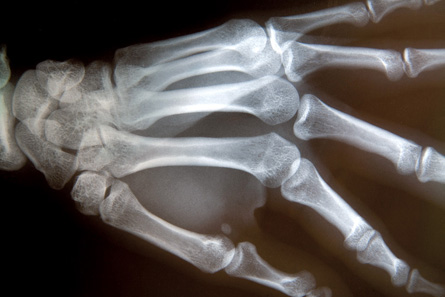Module 7
1. Module 7
1.15. Page 3
Module 7—Molecular Genetics: DNA, RNA, and Protein Synthesis
 Read
Read
Causes of Mutations

© Paul Maguire/shutterstock
induced mutation: permanent change in genetic material caused by a mutagen outside the cell
mutagen: substance or event that increases the rate of mutation in an organism
physical mutagen: agent that can forcibly break a nucleotide sequence, causing random changes in one or both strands of a DNA molecule (e.g., X-rays)
chemical mutagen: molecule that can enter the cell nucleus and induce a permanent change in the genetic material of the cell by reacting chemically with DNA (e.g., nitrites)
Some mutations are spontaneous and occur naturally in the cell. One cause of this type of mutation is incorrect base pairing by DNA polymerase during DNA replication.
Factors in our environment can also cause mutations. These mutations are referred to as induced mutations. There are two categories of mutagens that cause these induced mutations: physical and chemical. During an X-ray, the broken bone is exposed to the physical mutagen of radiation. Gasoline fumes are chemical mutagens. Read “Causes of Mutation” to the end of “Chemical Mutagens” on pages 644 to 645 of your textbook. To summarize this information, create a list of the chemical and physical mutagens, how they cause mutations, and what the outcome of the mutation can be (e.g., cancer).
The Internet and the video in the upcoming Watch and Listen activity will provide additional examples for your list. Place this list in your course folder for future reference when studying.
 Module 7: Lesson 5 Assignment
Module 7: Lesson 5 Assignment
Retrieve the copy of the Module 7: Lesson 4 Assignment that you saved to your computer earlier in this lesson. Complete “Thought Lab 18.3: Investigating Cancer Genes” on page 646 of your textbook and research a mutagen. Save your completed assignment in your course folder. You will receive instructions later in this lesson about when to submit your assignment to your teacher.
 Watch and Listen
Watch and Listen
The video “Genes, Mutations and Viruses: Alterations in the Genetic Code” is an excellent review of this lesson. It reviews mutations, discusses causes of mutations, and specifically discusses sickle cell anemia.
 Reflect and Connect
Reflect and Connect
Mutations can be a source of genetic variation in a population. Sometimes these random changes produce variations that can be adaptive and can give the organism a competitive advantage, for example the gene for sickle cell anemia imparting a resistance to malaria. Sometimes these changes have no effect. And sometimes these changes can have damaging effects, such as cancer. To review the concepts of mutation, complete the Self-Check section.
 Self-Check
Self-Check
Use the following information to answer SC 6 and SC 7.
The following matches the normal coding sequence, with the codons in the top row and the resulting amino acids in the bottom row. |
|||||||
mRNA codons |
– GUU |
– CAU |
– UUG |
– ACU |
– CCC |
– GAA |
– GAA |
amino acids |
– val |
– his |
– leu |
– thr |
– pro |
– glu |
– glu |
SC 6. Identify the type of mutation that would occur if the first codon were changed as follows: GUU is changed to GUC.
- frameshift mutation: This would cause the entire reading frame of a protein to be altered.
- silent mutation: This would have no effect on the cell’s metabolism.
SC 7. Identify the type of mutation that would occur if the third codon were changed as follows: UUG is changed to UAGG.
- frameshift mutation: This would cause the entire reading frame of the gene to be altered.
- silent mutation: This would have no effect on the cell’s metabolism.
SC 8. What type of point mutations occurred when the third codon was changed from UUG to UAGG in SC 7?
- substitution
- insertion
- deletion
SC 9. What type of point mutation occured when the second codon was changed from CAU to CAA in the question above?
- substitution
- insertion
- deletion
SC 10. For a substance to be classified as a mutagen, it must cause
- a change in DNA
- enzymes to denature
- protein production
- mRNA to be produced
SC 11. Distinguish between induced mutations and spontaneous mutations.
SC 12. Distinguish between chemical mutagen and physical mutagen; then give an example of each.
 Self-Check Answers
Self-Check Answers
SC 6. B
SC 7. A
SC 8. B
SC 9. A
SC 10. A
SC 11. A spontaneous mutation is a mutation that is caused by molecular interactions that take place naturally within cells. An induced mutation is caused by agents outside of the cell, such as certain factors in the environment.
SC 12. Physical mutagens cause changes in the structure of the DNA. High-energy radiation, such as those from X-rays and gamma rays, is the most damaging form of physical mutagen. A chemical mutagen is a molecule that can enter the nucleus of a cell and induce mutations by reacting chemically with the DNA. Examples of chemical mutagens include nitrites, gasoline fumes, and various compounds in cigarette smoke.
 Reflect on the Big Picture
Reflect on the Big Picture
The depiction of superheroes, like Bionic Woman, Superman, Spiderman, and the X-men, with new and amazing abilities, are not just factually unlikely, they are scientifically unsound. Or are they?
 Discuss
Discuss
Reflecting on your knowledge of DNA, replication and mutation, you are to create a discussion post that states your position on the possibility of a genetic superhero arising from the human population. What might be needed beyond the naturally occurring mutations and selection pressures to create a real genetic superhero? Justify your position and share your reflection with your teacher and your classmates in the discussion area.
 Module 7: Lesson 4 Assignment
Module 7: Lesson 4 Assignment
Submit your completed Module 7: Lesson 4 Assignment to your teacher for assessment.